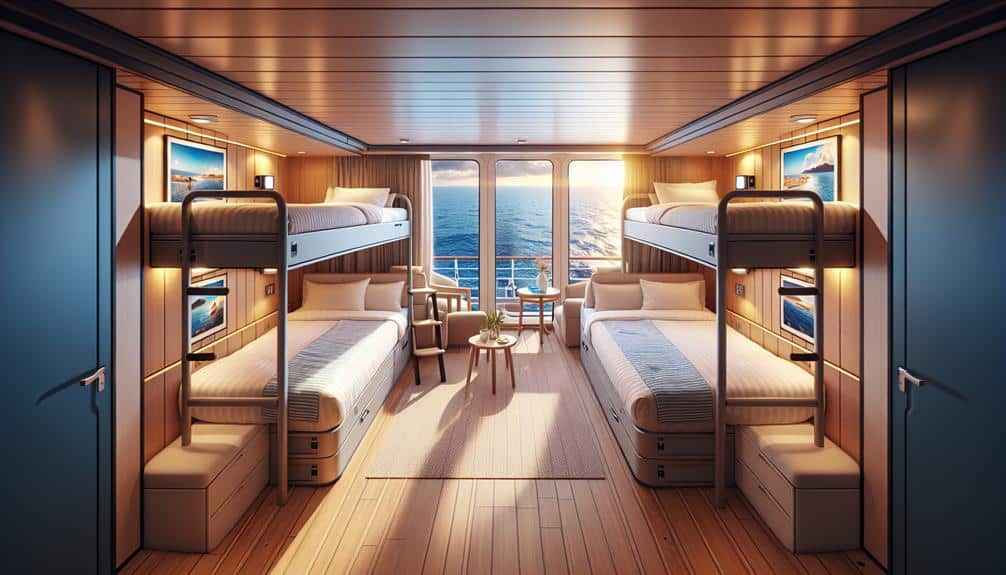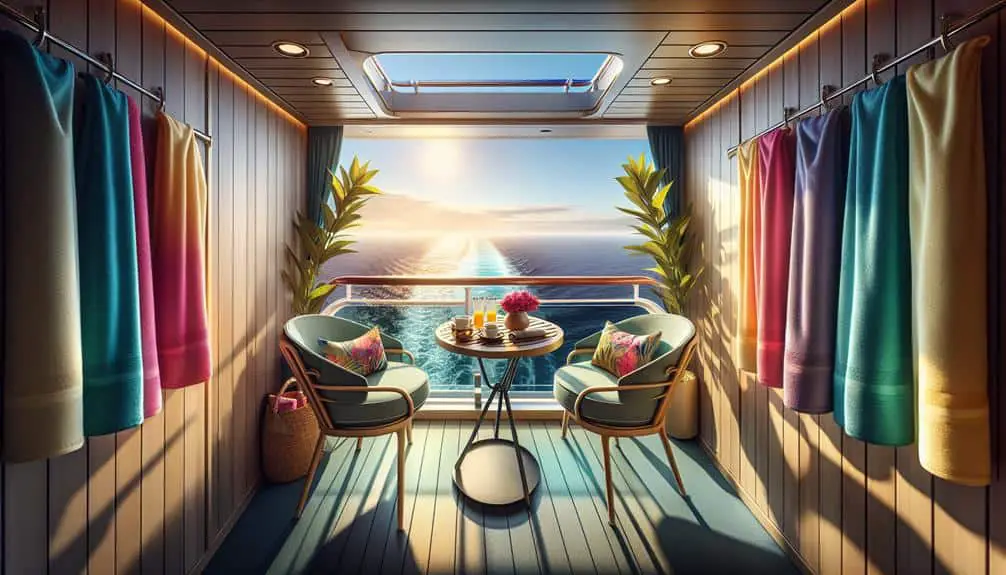On a cruise ship, essential cabin safety features include emergency lighting systems for clear exit routes, secure cabin locks for privacy, smoke detectors for early fire detection, vital railings on balconies to prevent falls, fire suppression equipment like sprinkler systems, emergency communication systems for quick responses, and ventilation systems ensuring air quality. These features adhere to strict regulations and are essential for passenger safety. Mastering these features will grant you peace of mind during your cruise voyage, knowing that your safety is a top priority onboard.
Key Points
- Emergency Lighting Systems guide passengers to safety.
- Secure Cabin Locks ensure passenger privacy and security.
- Smoke Detectors enhance fire hazard detection.
- Safety Railings on Balconies prevent falls.
- Fire Suppression Equipment minimizes fire risks.
Emergency Lighting Systems
In the event of a power outage or emergency situation, cruise ships are equipped with robust emergency lighting systems that automatically activate to guarantee passenger safety and navigation. These systems are strategically placed throughout the ship to illuminate emergency exit routes and ensure clear visibility for evacuation procedures in case of emergencies. Emergency lighting plays a vital role in guiding passengers to designated assembly points where they can access emergency lifeboats and life rafts.
Regulations mandate that cruise ships must have emergency lighting systems that meet specific brightness levels and coverage requirements to facilitate safe evacuation procedures. These systems are designed to remain operational even during power outages or emergencies, providing a reliable source of illumination for passengers and crew to navigate the ship safely. Regular maintenance and testing of these emergency lighting systems are essential to ensure their functionality and compliance with safety standards, guaranteeing a swift and orderly evacuation process in critical situations.
Secure Cabin Locks
Cruise ships are required to install secure cabin locks that comply with specific technical specifications and safety regulations to guarantee passenger security and privacy onboard. These locks must be robust, tamper-proof, and resistant to unauthorized access. Regular lock maintenance is essential to ensure they function correctly at all times. Cruise ship operators must adhere to stringent guidelines to address privacy concerns and prevent unauthorized entry into passenger cabins.
Proper lock maintenance includes regular inspections to check for any signs of wear or malfunction. Any issues identified during maintenance should be promptly addressed to prevent security vulnerabilities. Passengers can rest assured that their privacy is protected onboard through the installation of secure cabin locks that meet industry standards.
Privacy concerns on cruise ships are paramount, and secure cabin locks play an essential role in safeguarding passengers' personal space. By following strict regulations and conducting routine lock maintenance, cruise ship operators can uphold the highest standards of safety and privacy for all passengers.
Smoke Detectors Installation
To guarantee thorough safety measures onboard, the placement of smoke detectors in cabins is an essential component that enhances early detection of potential fire hazards. Fire prevention is a top priority on cruise ships, and smoke detectors play a pivotal role in ensuring a prompt response to any signs of fire. Safety protocols mandate that smoke detectors in cabins be interconnected to make sure all occupants are alerted simultaneously in case of smoke or fire. These detectors are strategically positioned near sleeping areas and common spaces to maximize coverage.
The installation of smoke detectors follows strict regulatory guidelines to meet industry standards. Regular maintenance and testing schedules are enforced to confirm the functionality of these devices at all times. In the event of a fire emergency, the early warning provided by smoke detectors can significantly improve the chances of a safe evacuation. Cruise ships are equipped with advanced fire suppression systems, and smoke detectors serve as the first line of defense by notifying passengers and crew to potential dangers promptly.
Safety Railings on Balconies
Guaranteeing compliance with safety regulations is crucial for cruise ship design and operation. The installation and maintenance of sturdy safety railings on balconies play a significant role in this aspect. Balcony heights on cruise ships are carefully regulated to prevent falls overboard, with safety railings typically installed at a minimum height of 42 inches. These railings are constructed to withstand considerable force and are regularly inspected to ensure their structural integrity.
In addition to robust railings, safety netting is sometimes installed as an extra precautionary measure. Safety netting acts as a secondary barrier, especially for balconies with larger spaces between railing posts. It serves as a backup protection to prevent objects from falling off the balcony and provides an additional layer of security.
Regular maintenance and inspections of safety railings and netting are essential to identify any signs of wear, corrosion, or damage promptly. Cruise ship staff are trained to monitor these safety features diligently to uphold the highest standards of passenger safety.
Fire Suppression Equipment
Proper maintenance and regular inspections of fire suppression equipment are vital for guaranteeing the safety of passengers and crew aboard cruise ships. Fire suppression technology on cruise ships includes automatic sprinkler systems, fire alarms, smoke detectors, and portable fire extinguishers strategically placed throughout the ship. These systems are designed to detect and suppress fires effectively, minimizing the risk of a fire spreading uncontrollably.
Cabin safety regulations mandate that cruise ships have robust fire suppression equipment in place to protect passengers and crew in the event of a fire emergency. Regular drills and training sessions are conducted to ensure that all personnel are familiar with the operation of fire suppression equipment and can respond swiftly and effectively in case of a fire.
Additionally, fire suppression technology on modern cruise ships often includes advanced systems such as water mist systems and CO2 flooding systems in engine rooms and other high-risk areas. These technologies enhance the ship's ability to combat fires promptly and prevent catastrophic incidents. Adhering to strict cabin safety regulations regarding fire suppression equipment is essential for maintaining a safe environment for all onboard.
Emergency Communication Systems
When examining emergency communication systems on cruise ships, it's essential to assess the effectiveness of onboard communication devices and alarm systems. These components play a vital role in alerting passengers and crew members in case of emergencies, facilitating timely responses and ensuring the safety of all individuals on board.
Regulations mandate that these systems are regularly tested and maintained to guarantee their reliability during unforeseen situations.
Communication Devices
Incorporate the latest satellite technology to guarantee seamless communication in emergency situations on cruise ships.
Intercom systems play a vital role in facilitating instant communication between crew members and passengers. These systems enable clear, real-time updates to be relayed throughout the ship, ensuring that everyone is informed promptly during emergencies.
Additionally, emergency beacons are strategically placed to assist in locating individuals in distress quickly. Mobile alerts are utilized to notify passengers of any urgent developments, while distress signals are transmitted to nearby vessels or onshore authorities for immediate assistance.
Alarm Systems
Deploy advanced alarm systems equipped with integrated emergency communication features to guarantee swift and accurate signaling during critical situations on cruise ships. These systems play an essential role in ensuring passenger and crew safety by providing timely alerts and instructions.
To maximize effectiveness, consider the following:
- Regular safety drills to familiarize passengers and crew with alarm signals
- Automated announcement systems for clear and consistent communication
- Integration with navigation systems to aid in evacuation procedures
- Continuous crew training to efficiently respond to alarms
- Passenger awareness campaigns to educate on emergency protocols and muster station locations.
Adequate Ventilation Systems
How effectively do ventilation systems guarantee air quality and safety on cruise ships?
Ventilation efficiency is vital for maintaining a healthy environment within cabins. Proper ventilation systems guarantee sufficient airflow, reducing the risk of airborne illnesses and providing a comfortable stay for passengers.
To achieve maximum ventilation efficiency, cruise ships must adhere to strict regulations that govern air quality control. These regulations specify the minimum requirements for ventilation systems, such as the rate of air exchange per hour and the use of high-efficiency filters to remove contaminants.
Cruise ships are also equipped with monitoring systems to continuously assess air quality and ensure that ventilation systems are functioning correctly. By prioritizing ventilation efficiency and air quality control, cruise ships can create a safe and pleasant onboard experience for all passengers.
Frequently Asked Questions
Are There Any Policies in Place to Prevent Overcrowding on Balconies in Case of Emergency?
During emergencies, strict policies regulate balcony safety to prevent overcrowding. Emergency protocols dictate limited balcony occupancy to guarantee swift evacuation. Adherence to these regulations is essential for passenger safety on cruise ships.
How Often Are Safety Inspections Conducted on Cabin Doors and Locks to Ensure They Are Functioning Properly?
Regular safety inspections and functionality checks on cabin doors and locks are mandated to guarantee proper operation. These inspections occur frequently to uphold compliance with regulations and ensure the safety of passengers.
Can Passengers Easily Access Emergency Oxygen Masks in Their Cabins in Case of a Fire or Other Emergency?
In case of an emergency, passengers can easily access emergency oxygen masks in their cabins. Safety drills familiarize guests with emergency exits and procedures, ensuring readiness. Regular inspections maintain the functionality of safety equipment for best preparedness.
Are There Any Protocols for Passengers With Disabilities or Mobility Limitations to Safely Evacuate Their Cabins in an Emergency?
In emergency situations on cruise ships, evacuation procedures must accommodate passengers with disabilities or mobility limitations. Emergency communication and accessibility measures are essential for ensuring all passengers can safely evacuate their cabins during crises.
How Are Passengers Alerted to Emergency Situations if They Are Not in Their Cabins, Such as During a Meal or on a Deck?
In case you're away from your cabin during an emergency, cruise ships employ various methods to alert passengers, like alarms, announcements, and crew instructions. Safety protocols guarantee everyone is informed and guided during emergency evacuation.




